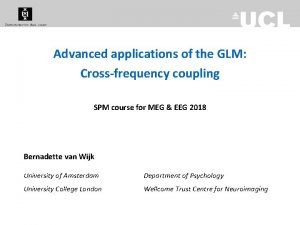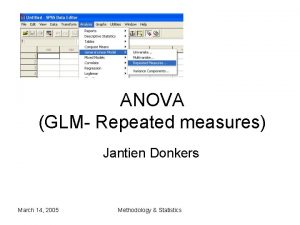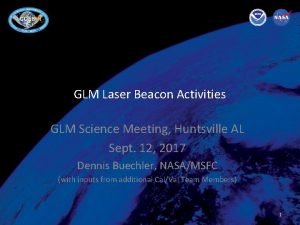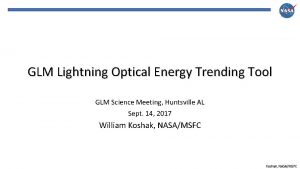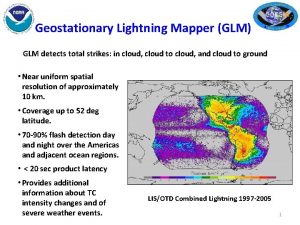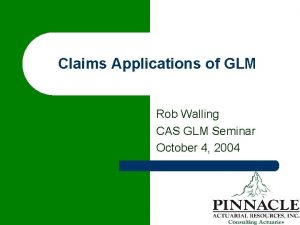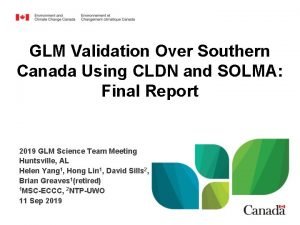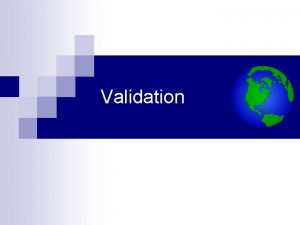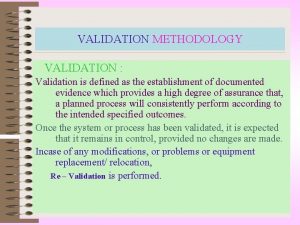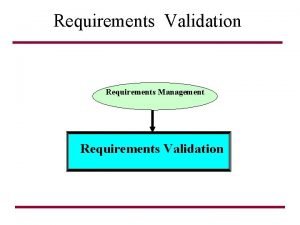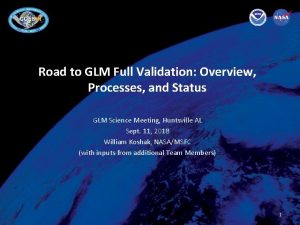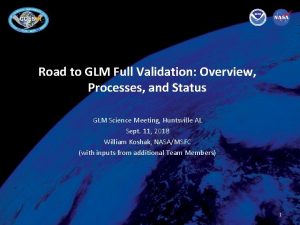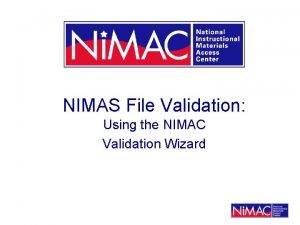GLM Validation at KSC using the KSC LMA

























- Slides: 25

GLM Validation at KSC using the KSC LMA Kenneth L. Cummins 1, Phillip Bitzer 2, and Daile Zhang 1, 3 1 Hydrology & Atmospheric Sciences, University of Arizona 2 Atmospheric Sciences, University of Alabama 3 CMNS, University of Maryland Air Force COTR: William Roeder NASA COTR: William Koshak GLM Science Meeting 2019 1

Purposes of the Study • Evaluate GLM performance as a function of 3 -dimensional flash extent using a high-performance VHF lightning mapping system • Evaluate GLM to determine its suitability for launch support, particularly for large distant thunderstorms that are not wellcharacterized by the local LLS systems GLM Science Meeting 2019 2

Lightning Mapping Coverage for GLM, MERLIN, and LMA MERLIN KSC LMA GOES-16 GLM March 20, 2018 18 -19 UTC March 20, 2018 19 -20 UTC GLM Science Meeting 2019 3

Technical Approach • Conceptual Bases: – LMA can be relied-upon to • determine the start and minimal duration of a flash • define the set of possible 3 -dimensional paths for higher-current processes – High-current processes can occur well after channel development depicted by LMA (so time coincidence requirements are very loose) GLM Science Meeting 2019 4

Technical Approach (cont. ) • Characterize LMA flashes in terms of: – – Duration Area (convex hull) Horizontal Extent (Major Axis) Main Channel Length Horizontal Extent is x A r o aj M 2 D View Convex Hull 3 D View Flash Origin GLM Science Meeting 2019 5

Technical Approach (cont. ) • Evaluate GLM Flash DE as a function of LMA flash parameters • Evaluate diurnal variation of DE vs. flash “size” • Analysis Period: – March 20, 2018 through February 27, 2019 (one full year) – ~250, 000 LMA flashes on 22 storm days GLM Science Meeting 2019 6

March 20, 2018 “canonical case” GLM Science Meeting 2019 7

Late-storm Anvil Flashes on March 20, 2018 GLM Science Meeting 2019 8

Missing Some Small Flashes (and late portion of a stratiform flash (left panel)) GLM Science Meeting 2019 9

Detection Analysis for Each Storm (Sample) GLM Science Meeting 2019 10

Detection Analysis for Each Storm 50 th percentile (median) GLM Science Meeting 2019 11

Overall Analysis Summary • Overall Flash DE: 73. 8% 22 storm days (25 storm cases) from March 20, 2018 through February 27, 2019 – – IC Flashes: 71. 8% CG Flashes: 86. 5% Short Flashes (<8 km): 40. 4% Long Flashes (>50 km): 96. 3% • Night DE: 10 -20% better • Average Detection Lag from start-of-flash – ~100 ms overall – ~38 ms at night GLM Science Meeting 2019 12

Full-year Diurnal DE (GLM and NLDN) Long Flashes • Modest diurnal variation All Flashes • ~25% diurnal variation for GLM Many-more daytime flashes • Note log scale GLM Science Meeting 2019 13

Summary → Mean daily flash DE ~74% (higher at night; better for CG) → Larger flash and/or longer flash => higher DE → Well-suited to support LLCC interpretation for anvil and stratiform cases (~95% DE for long flashes) → Diurnal DE variations are smaller for larger flashes § Larger flashes have brighter and larger groups → Frequently misses small (thus short duration) flashes More about this topic on Wednesday morning § Lower mean light production after I. B, until >100 ms into the flash § I. B. optical emissions are bright, but they are also small → Sometimes misses extensive channels in long flashes § Possibly due to smaller and dimmer optical emissions late in the flash § Does NOT fail to detect these flashes! 12 Science Meeting 2019 GLM 14

Backup Slides GLM Science Meeting 2019 15

Storm-scale Mapping (March 20, 2018) Within the body of the storm, the region of low “FED Detection Efficiency” was usually associated with regions having a high percentage of small flashes FED = Flash Extent Density GLM Science Meeting 2019 16

Storm-scale Time Evolution Averaged over the whole domain, lowest detection efficiency occurred when there was both a high percentage of small flashes (short duration and short channel length) and high IC fraction GLM Science Meeting 2019 17

Extensive Light Scattering (? ) (left panel) GLM Science Meeting 2019 18

Technical Approach (cont. ) • GLM Product: Individual “Groups” – 777. 4 nm cloud-top optical signal integrated over 2 ms periods • “groups” are spatially connected “events” (pixels) – CONTINUOUS (24 x 7) observations – Pixels fixed in space (Geostationary orbit) – ~8 x 8 km pixel size in central Florida • NLDN Product: CG strokes and “cloud pulses” – Sub-km location accuracy – Reports CG strokes in ~95% of all CG flashes – Reports “cloud pulses” in about half of all flashes GLM Science Meeting 2019 19

Technical Approach (cont. ) • Determine GLM “Flash” DE (GLM flashes NOT used) – One or more groups that “match” an LMA flash Temporal overlap with LMA flashes (+/- 4 ms beyond the LMA flash duration) • Spatial proximity of GLM group centroids (within 12 km (1. 5 pixels) of an LMA source) • Determine “CG Flash” (NLDN flashes NOT used) – One or more CG strokes that “match” an LMA flash • Temporal overlap with LMA flashes (+/- 4 ms beyond the LMA flash duration) • Spatial proximity of NLDN reports (within 4 km of an LMA source) GLM Science Meeting 2019 20

What might cause this GLM Behavior? Early “hint” of these findings (AGU Fall meeting, 2018) caused us to look-back at the time evolution of lightning optical emissions seen by the Lightning Imaging Sensor on the TRMM satellite Summarized in slides that follow (see Daile Zhang dissertation, Apr. 2019, for details) GLM Science Meeting 2019 21

Physical Basis for GLM Performance 9 Science Meeting 2019 GLM 22

Average LIS Flash Evolution with Different Flash Durations 11 Science Meeting 2019 GLM 23

Late-in-flash Detection Issue? Missed extensive channels 03/20/2018 20: 23: 10 – 20: 23: 15 10 Science Meeting 2019 GLM 24

Technical Approach (1) • Employ the KSC LMA as the Reference LLS – 3 D mapping of channels and branches • Good performance beyond 100 km from KSC • ~10 -20 m 2 D location accuracy • ~50 -100 m vertical accuracy • Detection “almost all” flashes GLM Science Meeting 2019 25
 Hava yolu açma aletleri
Hava yolu açma aletleri Retroglottic airway
Retroglottic airway What is this picture from
What is this picture from Tpwd twims
Tpwd twims Lma indications
Lma indications Intosai logo
Intosai logo China national audit office
China national audit office Ksc 5601
Ksc 5601 Glm nedir
Glm nedir Glm time
Glm time Glm
Glm Glm multiply vector by scalar
Glm multiply vector by scalar Glm cross
Glm cross Glm repeated measures
Glm repeated measures Thẻ vin
Thẻ vin Bàn tay mà dây bẩn
Bàn tay mà dây bẩn Các châu lục và đại dương trên thế giới
Các châu lục và đại dương trên thế giới Từ ngữ thể hiện lòng nhân hậu
Từ ngữ thể hiện lòng nhân hậu Bổ thể
Bổ thể Tư thế ngồi viết
Tư thế ngồi viết Diễn thế sinh thái là
Diễn thế sinh thái là V cc
V cc Phép trừ bù
Phép trừ bù Thể thơ truyền thống
Thể thơ truyền thống Hát lên người ơi alleluia
Hát lên người ơi alleluia Sự nuôi và dạy con của hổ
Sự nuôi và dạy con của hổ












